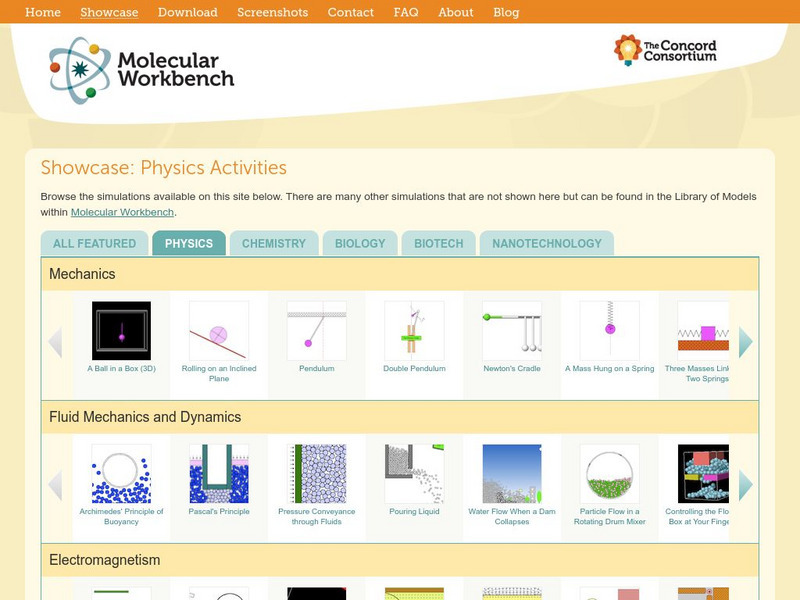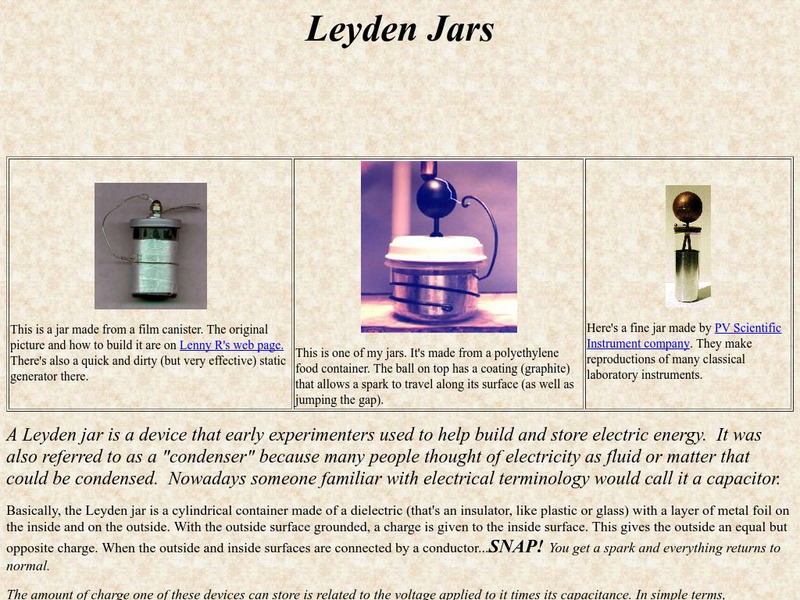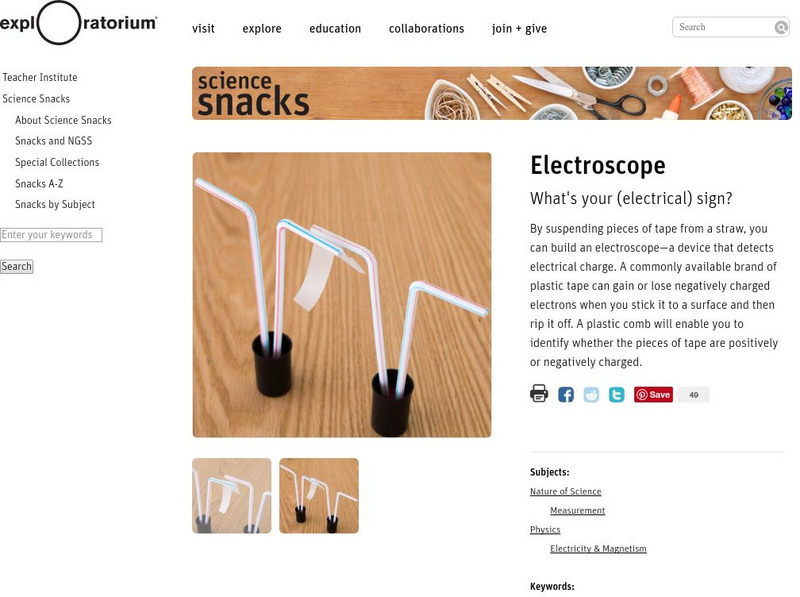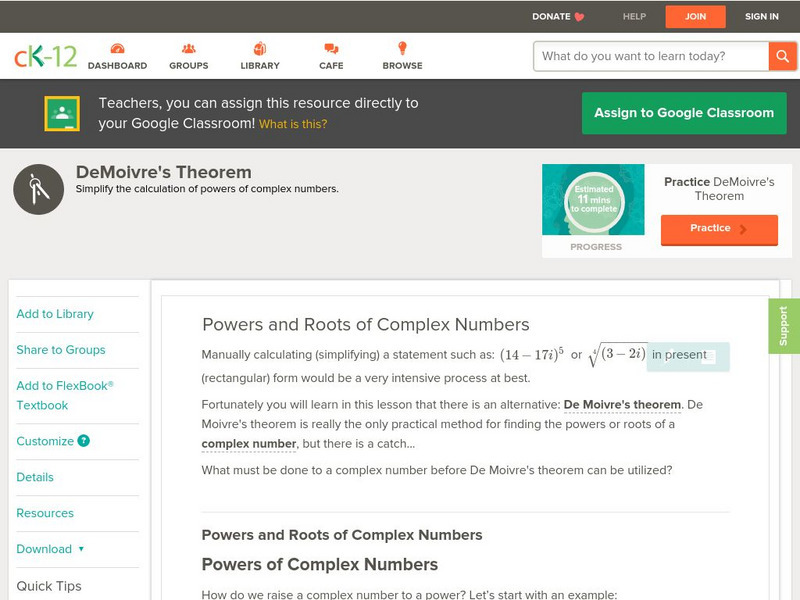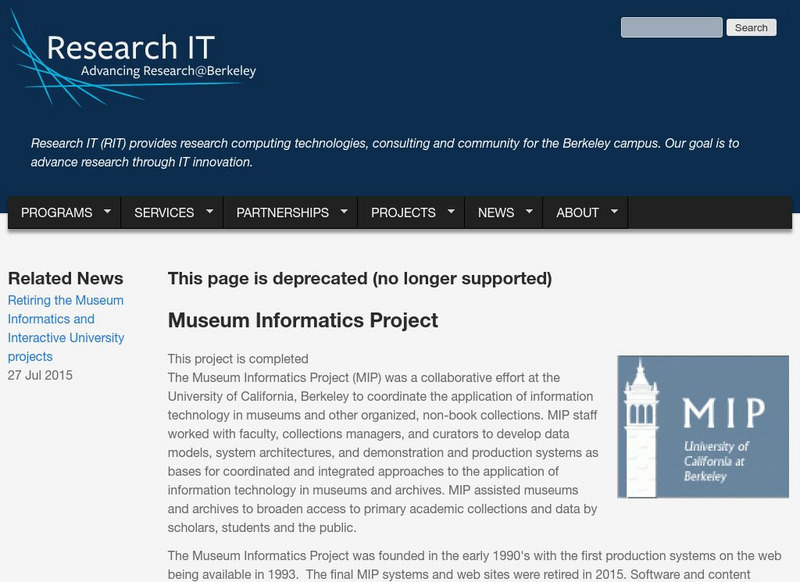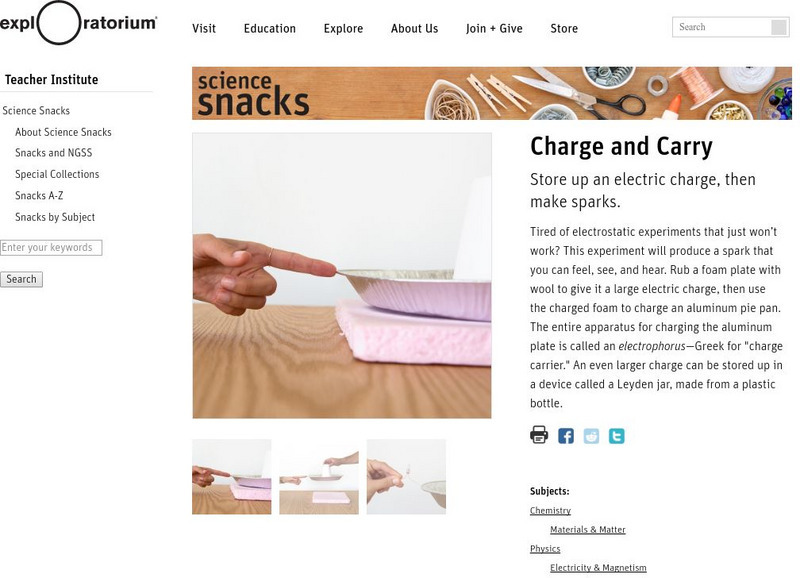Curated OER
Fall 2003 Midterm Exam #1
Electricity is the focus of this college-level midterm exam. It requres physics learners to answer multiple choice and short answer questions in addition to evaluating several diagrams and graphs. This is appropriate for most high school...
Curated OER
Coulomb's Law and Induced Polarization
Engage your aspiring physicists in a series of lab activities directied at demonstrating the behavior of electric force. In completing these exercises, learners will explore Coulomb's and Gauss's Laws. Well-written directions to four...
Curated OER
Static Electricity: Matching
Discovery Education has provided a series of quick quizzes on several topics. Here is one on static electricity. Young scientists match eight terms to their definitions. You can view the solution right from the page, so if you want to...
Curated OER
Electricity and Magnetism
A clear PowerPoint that gives many important facts regarding the topic of static electricity and charge is here for your students. Note: Although the title has the word "magnetism" in it, details of that concept are not covered.
Curated OER
Electroscope
Learners examine what an electroscope is and who invented it. In this electrical lesson students build their own Emergency Radiation detector Electroscope.
Curated OER
TE Activity: Build a Charge Detector
Students examine how electrical force takes place between two objects by building an electroscope. They apply the electroscope to determine an objects' charge intensity and to see what factors influence electric force.
Concord Consortium
Concord Consortium: Molecular Workbench Showcase: Physics, Electromagnetism
Students can use these simulations to understand concepts in electromagnetism. Simulations are available on the following concepts: Lorentz Force, The Hall Effect, capacitor, conductor, transistor, cyclotron, static electricity....
University of Kentucky
Elecroscope Lab
This site is actually a lab from the University of Kentucky Electrical Engineering Department. It is an excellent experiment that can be done at the high school level.
TeachEngineering
Teach Engineering: Build a Charge Detector
In this hands-on activity, students explore the electrical force that takes place between two objects. Each student builds an electroscope and uses the device to draw conclusions about objects' charge intensity. Students also determine...
Exploratorium
Exploratorium: Science Snacks: Physics/electricity & Magnetism
Exploratorium Science Snacks are miniature science exhibits and experiments that can be made with common, inexpensive, easily available materials. These electricity snacks represent a set of devices that you can build and experiment with...
PBS
Pbs Learning Media: Testing for Static Electricity
In this video segment adapted from ZOOM, cast members show you how to make your very own electroscope. You can use it to find out if an object is electrically charged. [4:17]
Other
Fun Science Ring: Leyden Jar
Everything you need to know about how Leyden jars work, and how to construct your own. Many pictures, references, other sites, other electrostatics projects and topics.
National High Magnetic Field Laboratory
Magnet Academy: Gold Leaf Electroscope 1787
For centuries, the electroscope was one of the most popular instruments used by scientists to study electricity. Abraham Bennet first described this version in 1787.
Exploratorium
Exploratorium: Science Snacks: Electroscope
In this activity, students will build electroscopes from common materials. With their electroscopes, students can then conduct experiments to find out what happens to charged objects.
Other
Science Hobbyist: Sticky Electrostatics
A series of activities focusing on charge interactions, charging methods, and the conservation of charge. Activities utilize scotch tape and other readily available items. Includes explanations of what is happening.
Physics Classroom
The Physics Classroom: Grounding a Positively Charged Electroscope
This Physics Classroom tutorial contains a simple animation demonstrating the grounding process for a positively-charged electroscope. The movement of electrons between the electroscope and ground is shown. An explanation accompanies the...
Physics Classroom
The Physics Classroom: Charging an Electroscope by Induction
From the Multimedia Physics Studios. An animation of the technique of the induction charging of an electroscope. The movement of electrons through the electroscope is shown. The animation is accompanied by explanations of what is happening.
CK-12 Foundation
Ck 12: Analysis: Problem Solving With Series Sums
[Free Registration/Login may be required to access all resource tools.] More on calculating the partial sums of arithmetic series.
Discovery Education
Discovery Education: 3 M Young Scientist Lab: Balloon Electroscope
Use balloons to make an electroscope and witness the effect of static charges before your very eyes.
Other
Museum of Science: Simple Electroscope
Resource explains how to build and use a simple electroscope.
University of California
University of California Berkeley: Charging an Electroscope by Induction
From the U.C. Berkeley Physics Lecture Demonstrations website. A thorough description of an activity in which a charged metal plate is used to charge an electroscope by induction. Complete directions and a diagram of the equipment and...
Physics Classroom
The Physics Classroom: Static Electricity Review
This review from the Glenbrook South High School provides a series of questions on various topics associated with static electricity (such as electrical insulation). Answers and explanations are hidden, yet easily accessed from within a...
Exploratorium
Exploratorium: Science Snacks: Charge and Carry
This site from The Exploratorium Museum is a full description of a short activity. An electrophorus plate and a Leyden jar are made. The electrophorus is charged by induction. Its charge is transferred to the Leyden jar by conduction...
Physics Classroom
The Physics Classroom: Negatively Charged Electroscope
From the Multimedia Physics Studios of the Glenbrook South High School. A tutorial containing a simple animation demonstrating the grounding process for a negatively-charged electroscope. The movement of electrons between the...








